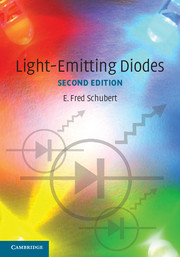Book contents
- Frontmatter
- Contents
- Preface
- 1 History of light-emitting diodes
- 2 Radiative and non-radiative recombination
- 3 Theory of radiative recombination
- 4 LED basics: Electrical properties
- 5 LED basics: Optical properties
- 6 Junction and carrier temperatures
- 7 High internal efficiency designs
- 8 Design of current flow
- 9 High extraction efficiency structures
- 10 Reflectors
- 11 Packaging
- 12 Visible-spectrum LEDs
- 13 The AlGaInN material system and ultraviolet emitters
- 14 Spontaneous emission from resonant cavities
- 15 Resonant-cavity light-emitting diodes
- 16 Human eye sensitivity and photometric qualities
- 17 Colorimetry
- 18 Planckian sources and color temperature
- 19 Color mixing and color rendering
- 20 White-light sources based on LEDs
- 21 White-light sources based on wavelength converters
- 22 Optical communication
- 23 Communication LEDs
- 24 LED modulation characteristics
- Appendix 1 Frequently used symbols
- Appendix 2 Physical constants
- Appendix 3 Room temperature properties of III–V arsenides
- Appendix 4 Room temperature properties of III–V nitrides
- Appendix 5 Room temperature properties of III–V phosphides
- Appendix 6 Room temperature properties of Si and Ge
- Appendix 7 Periodic system of elements (basic version)
- Appendix 8 Periodic system of elements (detailed version)
- Index
14 - Spontaneous emission from resonant cavities
Published online by Cambridge University Press: 05 September 2012
- Frontmatter
- Contents
- Preface
- 1 History of light-emitting diodes
- 2 Radiative and non-radiative recombination
- 3 Theory of radiative recombination
- 4 LED basics: Electrical properties
- 5 LED basics: Optical properties
- 6 Junction and carrier temperatures
- 7 High internal efficiency designs
- 8 Design of current flow
- 9 High extraction efficiency structures
- 10 Reflectors
- 11 Packaging
- 12 Visible-spectrum LEDs
- 13 The AlGaInN material system and ultraviolet emitters
- 14 Spontaneous emission from resonant cavities
- 15 Resonant-cavity light-emitting diodes
- 16 Human eye sensitivity and photometric qualities
- 17 Colorimetry
- 18 Planckian sources and color temperature
- 19 Color mixing and color rendering
- 20 White-light sources based on LEDs
- 21 White-light sources based on wavelength converters
- 22 Optical communication
- 23 Communication LEDs
- 24 LED modulation characteristics
- Appendix 1 Frequently used symbols
- Appendix 2 Physical constants
- Appendix 3 Room temperature properties of III–V arsenides
- Appendix 4 Room temperature properties of III–V nitrides
- Appendix 5 Room temperature properties of III–V phosphides
- Appendix 6 Room temperature properties of Si and Ge
- Appendix 7 Periodic system of elements (basic version)
- Appendix 8 Periodic system of elements (detailed version)
- Index
Summary
Modification of spontaneous emission
Radiative transitions, i.e. transitions of electrons from an initial quantum state to a final state and the simultaneous emission of a light quantum, are one of the most fundamental processes in optoelectronic devices. There are two distinct ways by which the emission of a photon can occur, namely by spontaneous and stimulated emission. These two processes were first postulated by Einstein (1917).
Stimulated emission is employed in semiconductor lasers and superluminescent LEDs. It was realized in the 1960s that the stimulated emission mode can be used in semiconductors to drastically change the radiative emission characteristics. The efforts to harness stimulated emission resulted in the first room-temperature operation of semiconductor lasers (Hayashi et al., 1970) and the first demonstration of a superluminescent LED (Hall et al., 1962).
Spontaneous emission implies the notion that the recombination process occurs spontaneously, that is without a means to influence this process. In fact, spontaneous emission has long been believed to be uncontrollable. However, research in microscopic optical resonators, where spatial dimensions are of the order of the wavelength of light, showed the possibility of controlling the spontaneous emission properties of a light-emitting medium. The changes of the emission properties include the spontaneous emission rate, spectral purity, and emission pattern. These changes can be employed to make more efficient, faster, and brighter semiconductor devices.
- Type
- Chapter
- Information
- Light-Emitting Diodes , pp. 239 - 254Publisher: Cambridge University PressPrint publication year: 2006
- 2
- Cited by



